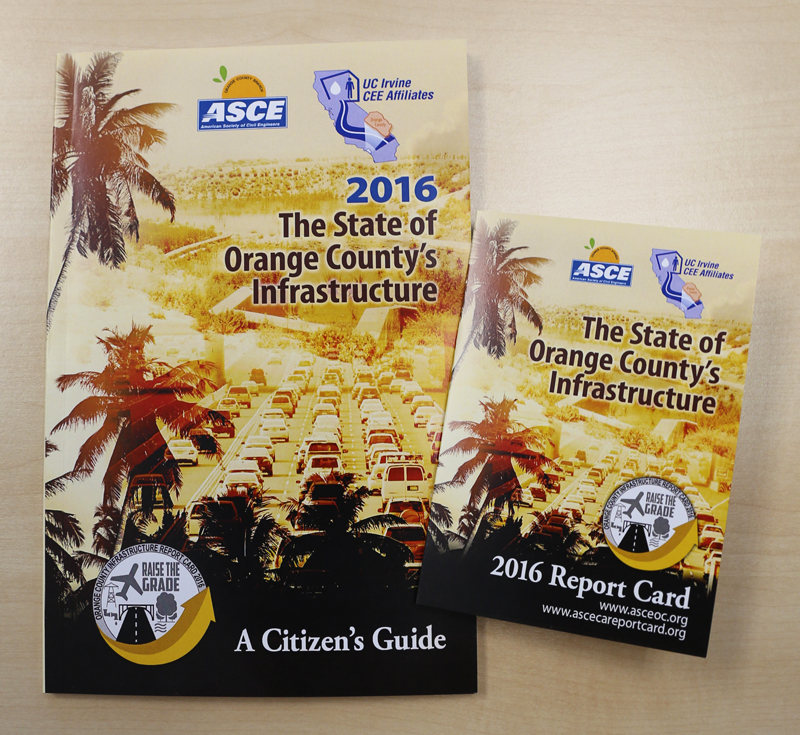Orange County Gets a C+ Overall in Latest ASCE Infrastructure Assessment
UCI engineering advisory group collaborated on report, which urges more investment July 21, 2016 – The Orange County branch of the American Society of Civil Engineers today released its 2016 Orange County Infrastructure Report Card, giving the county a C+ average in 12 categories. The report card was developed in collaboration with the UC Irvine Civil & Environmental Engineering Affiliates, an advisory group to the Department of Civil & Environmental Engineering in UCI’s Henry Samueli School of Engineering.
July 21, 2016 – The Orange County branch of the American Society of Civil Engineers today released its 2016 Orange County Infrastructure Report Card, giving the county a C+ average in 12 categories. The report card was developed in collaboration with the UC Irvine Civil & Environmental Engineering Affiliates, an advisory group to the Department of Civil & Environmental Engineering in UCI’s Henry Samueli School of Engineering.
The team assessed aviation (A-); electrical power (C-); flood control and levees (C-); ground transportation (C); natural gas (B-); oil (B-); parks, recreation and environment (C+); school facilities (C); solid waste (B); surface water quality (D+); wastewater (B); and water supply (B). This is the fourth Orange County Infrastructure Report Card. The first, released in 2002, resulted in a GPA of C; in the 2005 and 2010 analyses, the GPA stayed constant at C+.
“In this first assessment of Orange County’s infrastructure to be completed after the recession, we found that while some areas have improved incrementally, others have declined, leaving our overall GPA stalled for more than a decade,” said professional engineer Yaz Emrani, co-chair of the O.C. Infrastructure Report Card Executive Committee. “Since our infrastructure works as a system, it’s important that Orange County increase investment so that we can move from ‘catching up’ to ‘ready for the future.’ ”
Of note in the 2016 report:
- While commercial traffic at John Wayne Airport approaches the current negotiated limit of 10.8 million annual passengers until 2020, general aviation and military demand falls short of meeting the facility’s available capacity.
- Funding shortfalls for upgrades required to bring regional flood control facilities up to standard continue to be in excess of $2.7 billion.
- Deferred maintenance during the recent recession has exacerbated ground transportation needs. Existing funding sources are inadequate, and it’s estimated that Orange County needs an additional $133 million annually.
- The condition of school facilities has declined in the past five years because of the lack of funding.
- Due to the increased volume of runoff during rainstorms, surface water quality infrastructure in Orange County does not have nearly the capacity to meet wet weather demands.
Given these challenges, the Orange County branch of the American Society of Civil Engineers recommends the following:
- Performing continuous and timely maintenance to prolong use and minimize the need for costly repairs
- Conducting comprehensive planning and long-term investment to ensure sound decisions about infrastructure
- Preserving the environment while fostering economic growth and personal mobility
“The adequacy and vitality of Orange County’s infrastructure helps it stay competitive and is of paramount importance for supporting the county’s growth in population, range and business diversity,” said Farzad Naeim, co-chair of the O.C. Infrastructure Report Card Executive Committee and a UCI adjunct professor of civil & environmental engineering. “The ASCE Orange County branch and the UCI CEE Affiliates have done a heroic job in documenting the status and needs of the county’s infrastructure over the years.”
The Orange County Infrastructure Report Card was created as a public service to inform citizens and policymakers of the needs in their communities. To make their findings more understandable, the civil engineers convert complicated data into letter grades.
The analyses are modeled after the national Report Card for America’s Infrastructure, which gave the country a D+ in 2013. To view the full Orange County report, visit http://www.asceoc.org/documents/2016OCIRC.pdf.
-Becky Moylan, American Society of Civil Engineers
